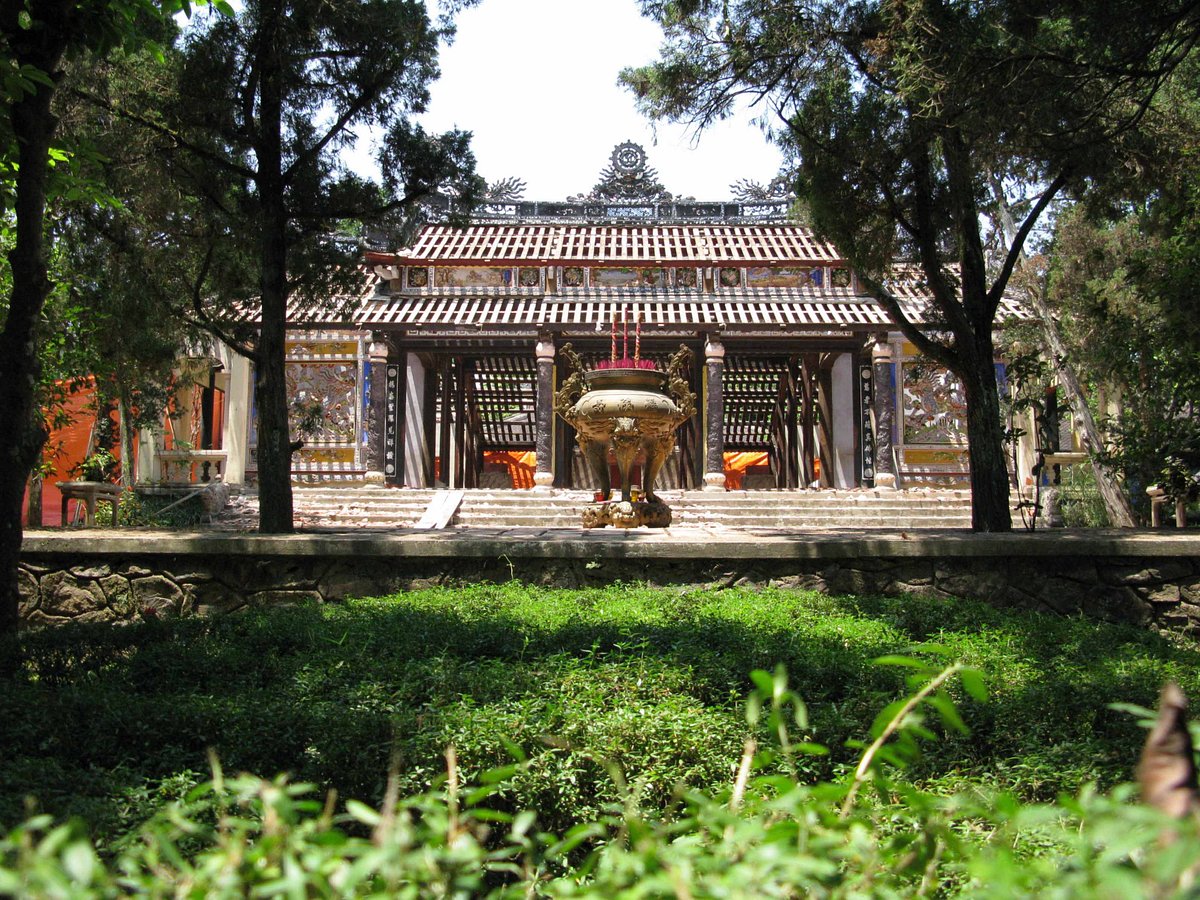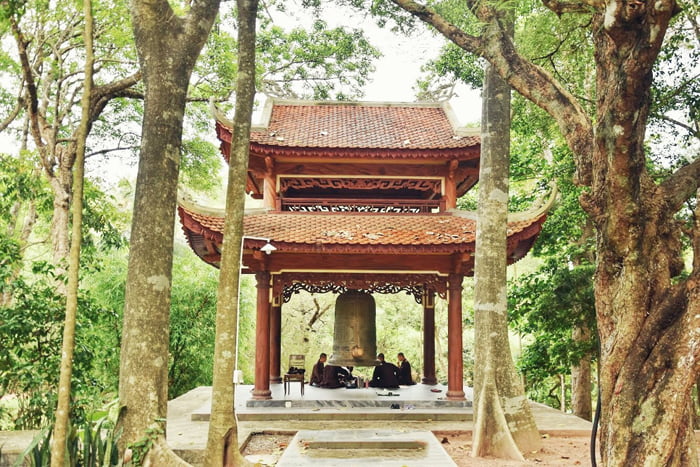Tu Hieu Pagoda (also known as the Eunuch pagoda) is hidden behind a large pine forest. This is a pagoda associated with the story of a son’s filial piety to his elderly mother. Besides, the pagoda is also the resting place of the eunuchs under the Nguyen Dynasty.

Plus, it is a unique pagoda in harmony with the bold ancient architecture of Hue Imperial City. Additionally, this is also a famous spiritual tourist destination with beautiful and peaceful scenery. Therefore, visitors should not miss this place.
Besides the Hue Royal Tombs of the Nguyen Dynasty. When traveling to Hue, do not forget to visit and admire the beautiful and ancient pagodas here. And Tu Hieu Pagoda is one of them. Let’s Private Car Transfer Hoi An discover how this pagoda has architecture and landscape that attracts so many visitors!
Table of Contents
Where is Tu Hieu Pagoda?
Tu Hieu Pagoda or Tu Hieu Communal House is the name of a pagoda. It is located in Duong Xuan Thuong III village, Thuy Xuan ward, Hue city, Thua Thien Hue province. The pagoda is one of the great ancient pagodas as well as a cultural and historical scenic spot of Hue Ancient Capital.
Tu Hieu pagoda is 5 km southwest of Hue Citadel. This pagoda was built in the Southeast direction. The total area of the campus is about 4.8 hectares, and the construction density is only 15% of the total area.
In addition to Huyen Khong Son Thuong pagoda, Tu Dam pagoda, Tu Hieu Pagoda are also among the famous Hue tourist destinations. Many tourists come here to enjoy the feeling of purity and peace and to admire the extremely poetic landscape.
How To Get To The Pagoda
Because it is only about 5 km from Hue city center. Thus, visitors can easily travel by motorbike, personal car, or taxi to Tu Hieu Pagoda. You should follow all the way to Dien Bien Phu. After that, turn to Le Ngo Cat street, then run for a while. You will see a signpost to go to the pagoda. This is a very famous place on the tourist map of Hue, so if you get lost, you can ask any local.
Furthermore, it takes tourists about 30 minutes to drive from Phu Bai International Airport. What is more, they may get there easily by motorbike, bike, or rent a Hue private car. Also, you can book our Hue city tour by private car with a strong engine and a professional English-speaking driver.
Tu Hieu Pagoda Hue – A Symbol of Filial Piety
King Tu Duc gave the name “Tu Hieu Tu” in the year he ascended the throne, associated with the story of Most Venerable Nhat Dinh‘s filial piety. The King is a person who cares for his mother as well. The Emperor thought and concept that he always promoted “maternal love” in Confucianism.
Tu Hieu Pagoda was originally known as the “Thao Am An Duong”, founded by Patriarch Nhat Dinh. He left the “Tang Cang Giac Quoc Tu” position in the palace. Then he retired to care for his elderly mother and practice purity here.
It is said that once, his mother was sick and seriously ill. As a filial son, he took care of the medicine every day, but his mother still couldn’t get better, so he had to feed her meat and fish to heal quickly. Therefore, every day he had to cross the forest with a stick for 5 km to buy meat and fish for his elderly mother to eat.
People speculated that he was a monk, but he broke the precept (eating salty foods), ignoring the gossip. He still continued dedicated to taking care of his elderly mother.
The story reached the ears of King Tu Duc, who was also a filial son. Hence, the king decreed a person to learn more about this, so the King knew the Zen master cooked porridge for his sick mother. But, he still ate vegetarian dishes every day, a spiritual practice.
Hence, the king heard that and was touched by the filial piety of the Zen master in the deep mountains of the same valley. Therefore, King Tu Duc gave the name “Sac tu Tu Hieu tu”, which means “son’s filial piety pagoda.” Hence, the pagoda was named Tu Hieu since then.
Tu Hieu Pagoda’s History
In 1843, after resigning as abbot and handing over the management of Bao Quoc pagoda to his younger brother in Dharma-Nhat Niem. The Most Ven Tanh Thien-Nhat Dinh built the Thao Am An Duong. He lived here to meditate and raise his elderly mother when he was 60 years old.

Next, in 1848, Most Ven Hai Thieu – Cuong Ky began to build a larger-scale pagoda. With the support of the court and the mandarins of the Nguyen Dynasty. Especially the eunuchs, who contributed money to take care of the work worship later on. And then Tu Hieu pagoda became a big pagoda. When the pagoda was completed, King Tu Duc gave the signboard “Sac tu Tu Hieu Tu”.
Until 50 years later, during the 6th reign of King Thanh Thai (Giap Ngo – 1894), Most Ven Cuong Ky began to restore a more spacious pagoda. In 1848, the Most Ven Hai Thieu – Cuong Ky began to build a larger-scale pagoda. With the support of the Royal Court, eunuchs, and Buddhists.
In 1894, the Most Venerable Cuong Ky continued to restore and construct the entire pagoda. With the help of King Thanh Thai, the eunuchs, and the Buddhists.
Plus, in 1931, the Most Venerable Thanh Thai-Hue Minh continued to restore and build a semicircular lake. In 1962, the Most Venerable Chon Thiet continued to restore and embellish the entire pagoda.
Lastly, in 1971, the Most Venerable Chi Niem restored the three-doors gate, the semicircular lake, and the damaged houses. And so far, the pagoda has been kept almost intact. Only other houses have been built to serve the learning and working needs of the monks in Tu Hieu pagoda.
What To Do In Tu Hieu Pagoda Hue
Admire Tu Hieu Pagoda’s Architecture
Not only associated with a touching story about filial piety, but Tu Hieu temple Hue Vietnam is also a harmonious combination. It is a combination of ancient architecture and natural scenery. Hence, it brings a sense of comfort and peace when you come here.
Besides the campus inside, the scenery around the pagoda is also very beautiful and poetic, with soaring pine forests, and clear lakes. It gives visitors a feeling of peace, tranquility, and relaxation. If you are a nature lover, you must not miss this rare tourist spot.
The Architectural Kind Of The Word “Khau” (Mouth)
The simplicity of Tu Hieu pagoda is reflected in the architecture of the word “Khau” (Mouth). With three traditional compartments and two lean-tos forming a closed whole. The main hall is the place to worship Buddha, behind is Quang Hieu Duong. On both sides of the pagoda’s yard, there are two stele floors to record the history of its formation through each period.
Moreover, the kind of closed structure “Khau” is formed from four blocks: the main hall, the rear house, the monk house, and the guest house. The main hall is always in the front, the back house (Quang Hieu Duong) is on the opposite side. The two sides are the guest house (Ta Lac Thien) on the left and the monk’s house (Huu Ai Nhat) on the right. The courtyard in the middle is arranged with bonsai to create landscape value and relax.
In terms of value, the structure of the word “Khau” creates a balance in the architectural unit. It ensures convenience in transportation, ventilation, and light. It also helps to preserve furniture, observe, and manage disciples.
Three – Doors Gate (Tam Quan Gate)
In front of the pagoda’s gate, they built a 3-floors tower in 1896. They used it as a place to store scriptures according to the king’s decree.
They built a three- doors gate in the style of a two-floors rolling arch with a roof. Above in the middle is the statue of the Dharma Protector. The gate has a very nice proportion of architectural lines, consisting of two floors, and three arches below.
On the upper floor, outside the “gazebo”, there are two more fake floors built high, covered with tile roofs. They are embossed with the image of “long ma tai ha do” made of porcelain and glass. The part between the two floors is decorated with convex and concave patterns.
As soon as you step through the gate of the pagoda, you will see a semicircular lake. In this lake, they planted lotus flowers and raised ornamental fish such as catfish, turtles, etc.
The Main Hall
Unlike many other pagodas, besides the statues of Tam The Buddha and Shakyamuni Buddha. Tu Hieu pagoda worship the Buddhas’ paintings instead of statues is also a special feature that makes the sacred place of worship become closer.
At the Buddha shrine, they worship Tam The Buddha on the high of the main nave. Below, in front, they worship Shakyamuni Buddha. On both sides, they worship Avalokiteśvara Bodhisattva and Kitigarbha Bodhisattva. In addition, there are two rows, they worship the eighteen Arhats by paintings. In the Tien Duong area, they worship Long Thien Ho Phap.
The Back House – Quang Hieu Duong
Crossing the courtyard in the middle with many kinds of ornamental plants is the back house, also known as Quang Hieu Duong. This is the place to worship the Duc Thanh Quan, the soul of home Buddhists, the eunuchs who have contributed to constructing the pagoda, and so on.
In addition, there is also an altar to worship Field Marshal Le Van Duyet (also called Ta Quan Duyet), his wooden horse, and his greatsword.
Grave Towers
Around Tu Hieu Pagoda, there are many tombs of concubines of the Nguyen Dynasty and tomb towers of famous monks. Furthermore, all the grave towers of Tu Hieu pagoda Hue are the burial towers of the abbots, and the high monks of Tu Hieu pagoda occupy the main part.
Besides, there are the graves of the Mandarins and Eunuchs in the palace. Plus, Buddhists have made great contributions to the pagoda. In particular, right next to the main hall is the grave and stupa keeping the body of Zen Master Nhat Dinh, the founder of Tu Hieu Pagoda.
Visiting The Eunuch Graves
Many visitors who come to Tu Hieu pagoda are extremely curious about a cemetery located on the pagoda’s own campus. Few people know that it is a unique cemetery, the resting place of more than 24 eunuchs of the Nguyen Dynasty.
After Zen master Nhat Dinh passed away, Thao Am An Duong was repaired and expanded into Tu Hieu pagoda. With the help of an eunuch named Chau Phuoc Nang. He was the one who realized the fate of eunuchs like himself when he was old, had no relatives, and was helpless.
To have a place of worship when they died, he called on the eunuchs in the royal court to donate. Expanding the pagoda so that they could have a resting place later on. This work was later approved by King Tu Duc. Because of their contribution to the construction of the pagoda, after the eunuchs died, they were buried on a small hill next to the Tu Hieu pagoda. Hence, this pagoda is also known as the Eunuch Pagoda.
Today, this cemetery is located to the right of the pagoda with an area of nearly 1000m2, surrounded by protective walls about 1.5m high. More than 24 graves are divided into three rows, arranged from small to large according to the position of the old eunuchs. In the middle is a stele inscribed with their contributions to the royal court.
On the whole, with a beautiful, quiet, and cool location, in contrast to the hustle and bustle of urban life. On holidays, Tu Hieu pagoda welcomes a large number of visitors to visit and picnic. If you feel tired and pressured by life, Tu Hieu Pagoda Hue is a place to help you calm down and relax. Besides, you can immerse yourself in a peaceful and comfortable natural place. Phong Nha Locals Travel ensures that you will forget your sadness and worries when coming here.



